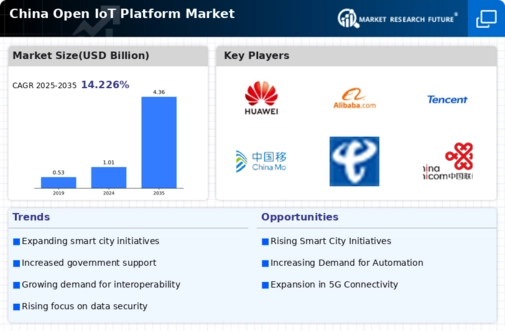Expansion of 5G Networks
The rollout of 5G networks in China is set to revolutionize the open iot-platform market. With significantly higher data transfer speeds and lower latency, 5G technology enables more devices to connect seamlessly. This expansion is expected to facilitate the deployment of advanced IoT applications, such as real-time monitoring and autonomous systems. By 2025, it is anticipated that 5G will cover over 90% of urban areas in China, providing a robust infrastructure for the open iot-platform market. The enhanced connectivity offered by 5G is likely to drive adoption rates and expand the potential applications of IoT solutions.
Growing Investment in R&D
Investment in research and development (R&D) is a pivotal driver for the open iot-platform market. In China, both public and private sectors are channeling funds into R&D to foster innovation in IoT technologies. The government has launched initiatives to support startups and tech companies, with funding reaching billions of dollars annually. This influx of capital is likely to accelerate the development of new open iot-platform solutions, enhancing their functionality and user experience. As a result, the open iot-platform market is poised for growth, driven by continuous innovation and technological breakthroughs.
Rising Cybersecurity Concerns
As the open iot-platform market expands, so do concerns regarding cybersecurity. In China, the increasing number of connected devices has raised alarms about data breaches and cyber threats. The government has recognized this challenge and is implementing stricter cybersecurity regulations, which could drive the demand for secure open iot-platform solutions. Companies are likely to invest in advanced security measures to protect sensitive data, thereby creating opportunities for growth within the market. The emphasis on cybersecurity is expected to shape the development of open iot-platforms, ensuring they meet the necessary security standards.
Increased Demand for Smart Cities
The push towards smart city initiatives in China is significantly influencing the open iot-platform market. Urbanization has led to a growing need for efficient resource management, traffic control, and public safety solutions. The Chinese government has committed substantial investments, with estimates suggesting that smart city projects could exceed $1 trillion by 2030. This demand for interconnected systems necessitates the deployment of open iot-platforms that can facilitate data sharing and interoperability among various city services. Consequently, the open iot-platform market is likely to experience accelerated growth as cities adopt these technologies to enhance urban living.
Technological Advancements in IoT
The rapid pace of technological advancements in IoT is a crucial driver for the open iot-platform market. Innovations in sensor technology, data analytics, and cloud computing are enhancing the capabilities of IoT platforms. In China, the integration of AI and machine learning into IoT systems is expected to boost efficiency and data processing capabilities. As of 2025, the market for IoT devices in China is projected to reach approximately $200 billion, indicating a robust growth trajectory. This technological evolution not only improves operational efficiencies but also fosters the development of new applications across various sectors, thereby expanding the open iot-platform market.



















Leave a Comment